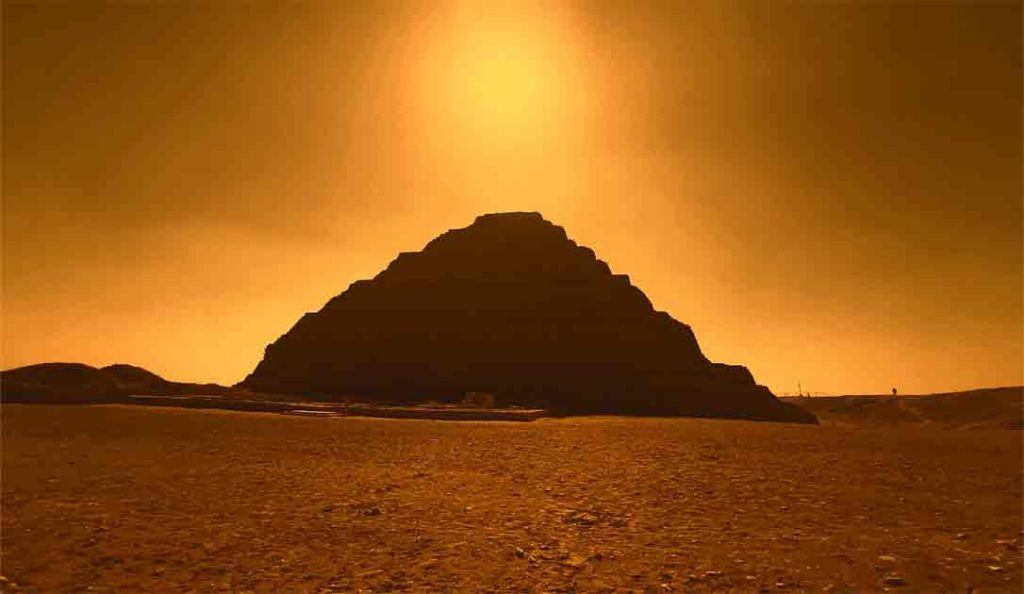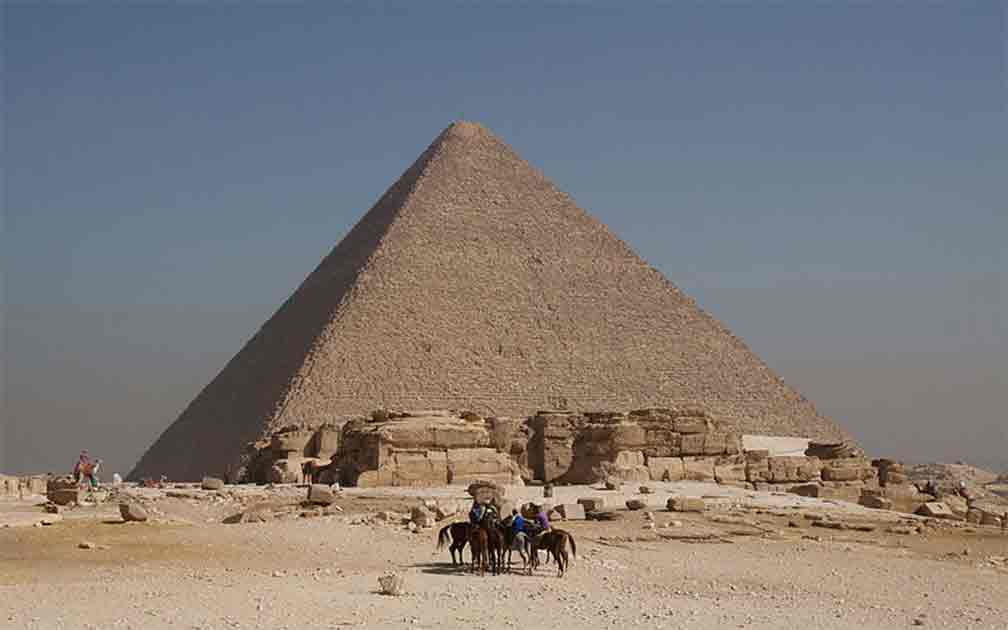The vast and impossibly ancient necropolis in Saqqara in the Egyptian desert is filled with wonders. Seventeen Egyptian kings and queens chose this site for their burial ground, building pyramids and tombs here for the afterlife.
These are not the largest or the best-preserved pyramids in all of Egypt to be sure. But they are the very oldest, and nestled amongst them is the step pyramid of Djoser, the oldest of them all.
This pyramid is believed to be at the center of the oldest complete stone building complex in history. It cannot be overstated how monumental this project was: from this first structure came all of Egyptian pyramid building, spanning thousands of years.
What caused the Pharaoh known as Djoser to build such a strange tomb? And what do we know about the enigmatic pharaoh himself, and the world in which he lived?
A Tomb for All Time
Ruling during Egypt’s Third Dynasty around 2670–2640 BCE, Djoser’s reign heralded the dawn of the Old Kingdom. This was the first time Egypt was truly united under a single ruler, and was an era that saw the flourishing of pyramid construction which would define millennia of Egyptian culture.
Pharaoh Djoser, known to his people as Netjerikhet, meaning “divine of body,” is often credited with being the architect of this consolidation of royal power and the centralization of the state. His decision to erect a pyramid was both a religious and a political act, symbolizing his unrivaled authority and his connection to the divine.

The pyramid itself was designed by his vizier, Imhotep, who would later be deified for his architectural innovations. Imhotep’s design was revolutionary, transforming the traditional mastaba (a flat-roofed, rectangular tomb) into a towering, six-stepped structure that stretched towards the heavens. And, crucially, he built it in stone, for it was to last forever.
The purpose behind Djoser’s pyramid transcends mere burial; it was a statement of godliness, intended to ensure his eternal life and continued rule in the afterlife. This structure served as the centerpiece of a vast funerary complex, where rituals could be performed to sustain the deceased king’s soul.
- (In Pics) Ancient and Everywhere: Pyramids Around the World
- Gunung Padang: The Oldest Pyramid in the World?
The pyramid’s several layers represented the (almost literal) steps Djoser would climb to join the sun god Ra, reflecting the deepening relationship between the pharaoh and the divine. Djoser was the first to gather all power to himself, and so he needed something unprecedented to remain after his death to show his kingdom he had not died as an ordinary man, but passed on, as a god.
Of course, every pharaoh that came after wanted to claim this too: it was a handy shortcut to legitimacy. Following Djoser, the tradition of pyramid building became a central feature of Egyptian culture, reflecting the society’s complex spiritual beliefs about the afterlife.
Each pyramid that rose from the sands of Egypt was not only a tomb but also a launchpad for the pharaoh’s soul, facilitating his journey to the afterlife and his transformation into a god. This belief system was rooted in the notion of “ma’at,” or cosmic order, which the pharaoh was responsible for maintaining both in life and in death.
But the pyramid shape itself was not envisaged from the start. Imhotep had planned that a raised structure would lift the man associated with it closer to heaven, it is true, similar to how spires in Christian churches point at the sky.
But this could have been in almost any shape, perhaps as a tower or some other structure. The pyramid was chosen because it was the most stable of structures and the most likely to endure, as indeed it did.
And, just as later pharaohs cottoned on to the idea that having a pyramid made them a god, so they realized that having a better pyramid made them a better god. The evolution from Djoser’s step pyramid to the smooth-sided pyramids that epitomize ancient Egypt from this point was rapid.
Sneferu, Djoser’s successor, experimented with several forms before perfecting the true pyramid shape, culminating in the Red Pyramid at Dahshur. His innovations paved the way for his son, Khufu, to construct the unfathomably enormous Great Pyramid of Giza, one of the Seven Wonders of the Ancient World.

These developments were not merely architectural but symbolized the evolution of Egyptian theological and cosmological ideas. The groundwork for the entire millennia-long theology of ancient Egypt was centered around these early constructions, and was created in only a few generations.
Pyramids Forever
The proliferation of pyramids following Djoser’s reign speaks to the structure’s success in embodying the aspirations and beliefs of ancient Egypt. The pyramid form continued to be refined and enlarged until the end of the Middle Kingdom a thousand years later.
For all this time, each successive pyramid served as a powerful reminder of the pharaohs’ dual role as earthly kings and divine intermediaries. Each one, while unique in its construction and complexity, carried forward the legacy of Djoser’s original vision: a vision of eternity and divine ascent.
Despite their grandeur, the pyramids were not impervious to the passage of time. Over millennia, many were plundered and stripped of their treasures.
- The Witch, the Dwarf and the Magic Tortilla: the Pyramid of the Magician
- The Hellinikon: were the Greeks building Pyramids before Egypt?
Yet, they continue to stand as testaments to the ingenuity and spiritual depth of ancient Egyptian civilization. Today, Djoser’s pyramid at Saqqara remains a focal point for both scholarly research and popular fascination, drawing visitors from around the world eager to glimpse the origins of pyramid construction.
And it becomes clear with this realization that we miss a lot of that importance in our fascination with ancient Egypt today. We perhaps focus too much on the treasures preserved by the desert and less on the culture which produced such masterpieces. More of Tutankhamun’s glorious funerary mask, and less on his cult of the afterlife.
As we reflect on the questions posed by Djoser’s monumental undertaking, it becomes clear that while we have unearthed much about how these structures were built, the full understanding of why continues to elude us. The pyramids of Egypt, beginning with Djoser’s, are enveloped in an aura of mystery, compelling us to look deeper into the sands of time to uncover more about this fascinating civilization.

The legacy of Djoser and his pyramid is a story of innovation, belief, and the eternal human desire to reach beyond the mortal realm, resonating through the ages as a profound symbol of cultural achievement. Did Djoser himself believe that, in constructing such a tomb, he would achieve immortality and divinity? Did he believe himself immortal and divine already?
And what of those who came after? Did they follow Djoser’s example because they saw a useful lever of statecraft, and chose to employ the “divine” myth that built up around the pharaoh as an efficient way to consolidate and maintain royal authority?
The enormous pyramid Khufu built would seem to belie that, far too large and extensive an undertaking to serve only that purpose. Certainly if the pharaoh was going legacy shopping, a smaller pyramid would have sufficed while being much easier and less time consuming.
Were these ancient pharaohs high on their own supply? Had they allowed the fact of their own success, or a burgeoning cult priesthood, to convince them of their own divinity?
Or had they seen something else out there in the desert and on the banks of the Nile, which meant they knew more than other mortal men?
Top Image: The pyramid of Djoser may not be the largest but it is still enormous, dwarfing the mastaba tombs at Saqqara. Source: Dordo / Adobe Stock.
By HM Editorial Staff